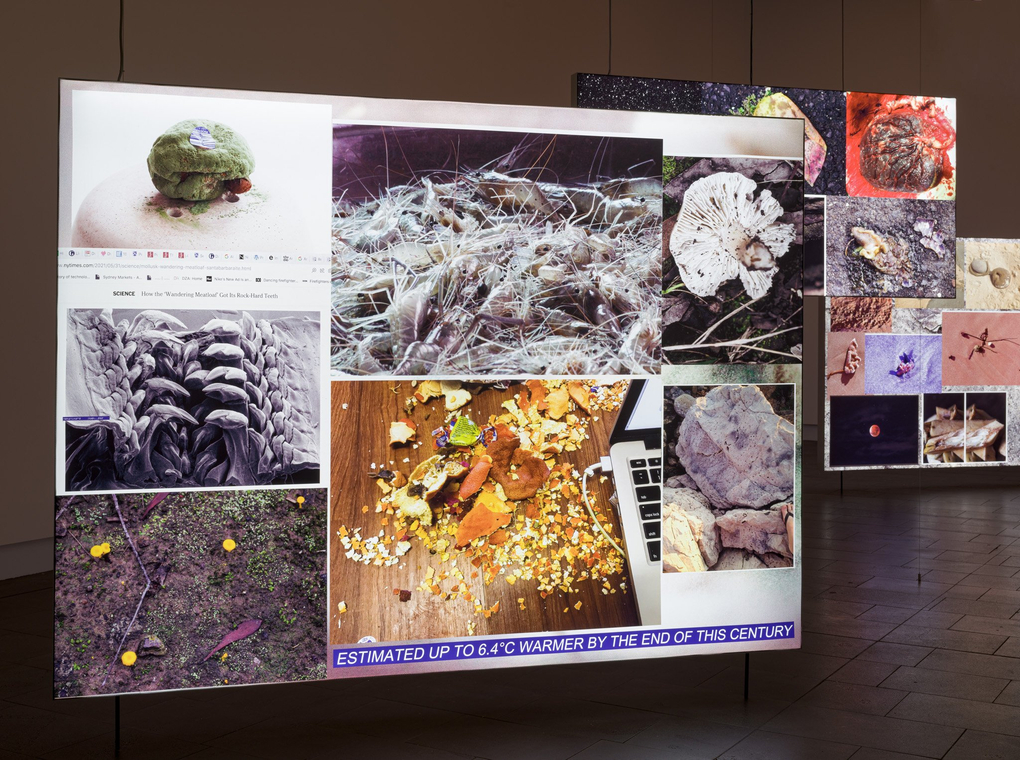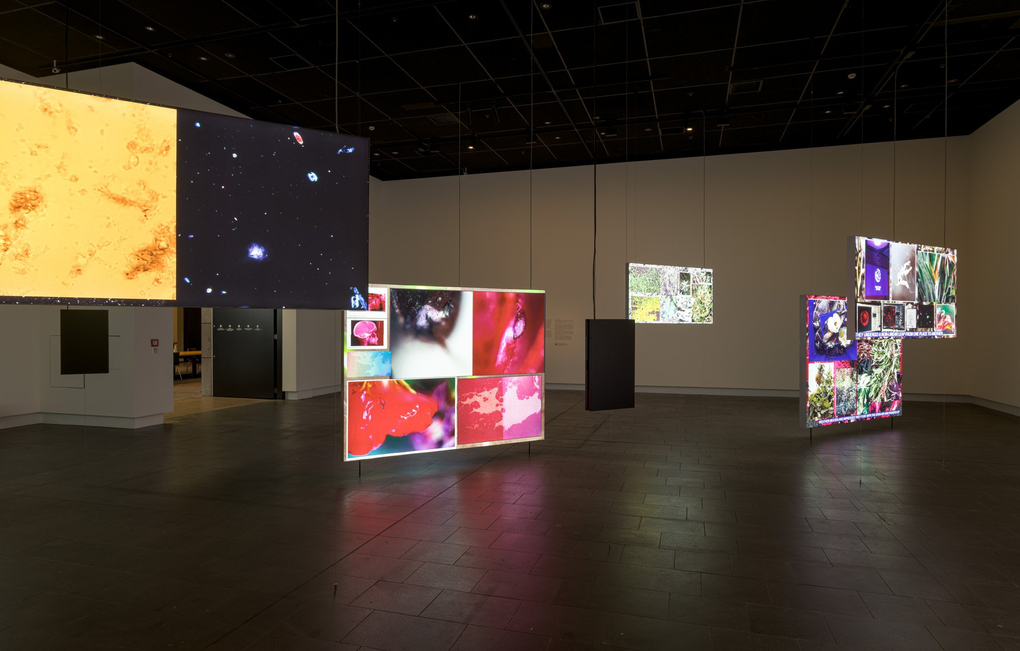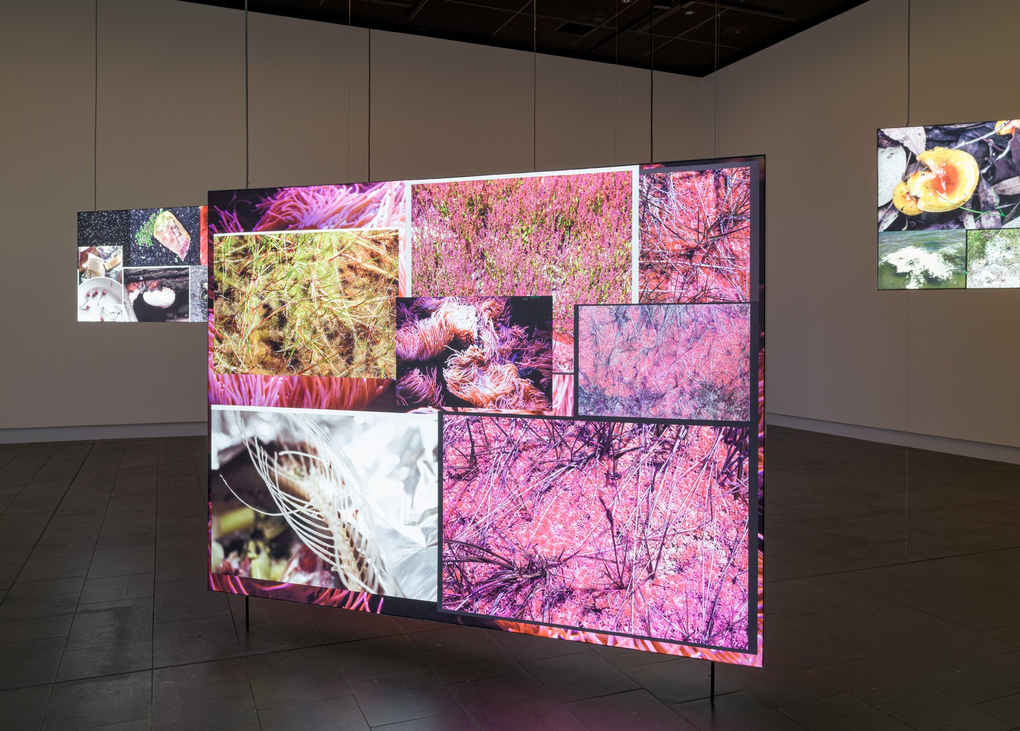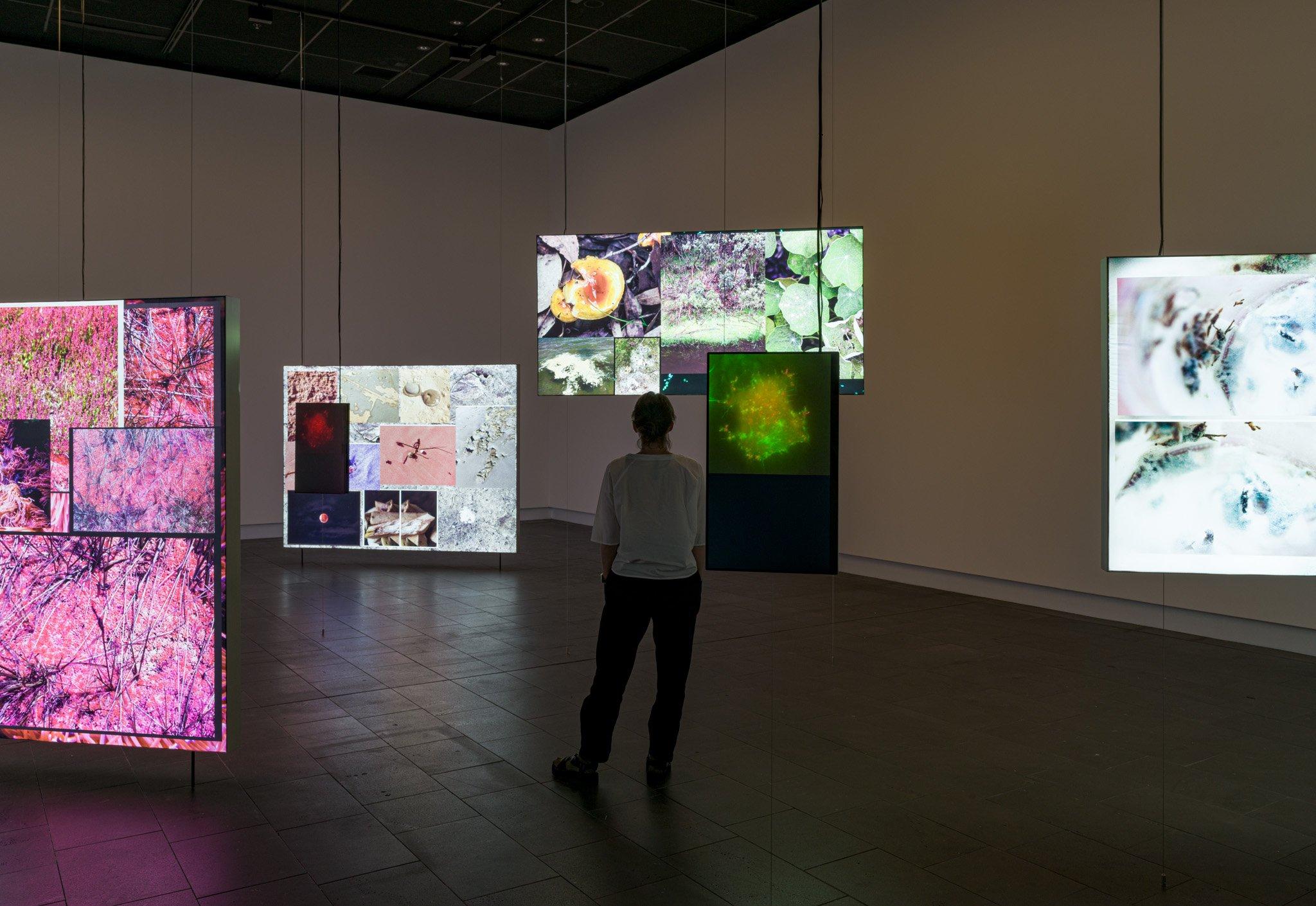Carl Linnaeus might have founded the taxonomic table, classifying the world’s fauna and flora into an assembly for human delectation, but he also radically reorientated our view of plants and animals as a world unto themselves. In fact, Linnaeus deliberately took a “salty delight in drawing parallels between the sexual lives of plants and humans”(1) because it involved a recognition of the freedom of flora to enjoy a kind of autonomy, if not jouissance, that was previously subsumed under the predilections of Christian orthodoxy. So, for every instance in which we see the Linnean taxonomy substituted as the sybaritic bedfellow of Western modernity’s ongoing imperative to classify and impose order upon the world, we miss the nuanced ability of this taxonomy to translate these zoomorphic attributes that attest to a world and motive beyond our control.
Presumably Linnaeus’s taxonomic system underpins Alicia Frankovich’s Atlas of Anti-Taxonomies, a collection of eight double-sided lightboxes and three smaller video monitors, but it does so in both critical and generative ways. For instance, Frankovich rightfully picks apart the taxonomic impulse to subsume the world as a subject to be tamed and mastered. This is, I think, achieved by a kind of mockery, one evinced by the works’ over saturation, its overload of too many disparate images. Frankovich delights in the profusion or over propagation of the unclassifiable. It mocks the tabulated branches and correlations of Linnaeus’ system.
Frankovich’s lightboxes jump from one image to the next, creating an unruly assembly, that mingles rotting fruit and vegetables, moss laden branches, water scenes, dismembered crabs, and molluscs with iron teeth. It is all too chaotic, but Frankovich’s collation of seemingly disparate images deliberately confuses and disorientates. Perhaps we could take a cue here from the lightboxes’ mimicry of corporate advertising to witness that familiar denunciation of green-wash initiatives. This though is a laconic criticality at best, undercut by Frankovich’s predilection for the grotesque (rotting fruit, mould spores…), granting her work a humorous touch, but is also highly indicative that such disjunction is generative in intent.
Frankovich delights in the profusion or over propagation of the unclassifiable. It mocks the tabulated branches and correlations of Linnaeus’ system.

Alicia Frankovich Atlas of Anti-Taxonomies 2019–22. 16 dye-sublimation prints on PVC backlit polyester; 3 SD videos, colour, vertical, duration 5 secs. Installation view at Christchurch Art Gallery Te Puna o Waiwhetū. Courtesy of the artist, Starkwhite Auckland and 1301SW Melbourne
From the outset it is obvious that the dislocations and overlays that Frankovich employs are not merely to mock or impose the cruel realism of a scolding eco-criticism that’s already embraced the obvious fact that the world will, as one of her lightboxes states, be “6.4 C warmer by the end of this century.” Rather, the sheer profusion of images propagates a different kind of connection. Recall here Deleuze and Guattari’s preference for contagion over filiation as nature’s organising principle. Take for instance their famous example of the truffle, that amalgamation of the tree, the fly, and the pig. These heterogenous entities all converge in a way that is “neither genetic nor structural” but a kind of “interkingdom”, an assemblage of symbiosis.(2) Or look perhaps at Bruno Latour’s description of the sommelier as the “nose”.(3) Do they not become a disjointed human, compacted now into the one momentary organ. Does this not underscore just how much symbiosis unravels the principle of the consolidated subject. The sommelier is no longer an identifiable human but a nose entangled in the aromas of the grape. The truffle is similarly no longer an object of delectation but an associative entity wrapped up in a chain of persuasive actors. Perhaps now then we begin to appreciate the generative possibilities of a taxonomic system that is no longer enthralled to the filiation of identifiable partners.
Frankovich’s Atlas poses an indifferent world, a nature not beholden to the expectations of whatever paradigm we wrap around it. Frankovich alerts us to this insight by proclaiming across the bottom of a lightbox that, “there is an undoing of the question of whole earth and whole subject”. This is a useful correlation, borrowing from the phallogocentric critique of the mastering subject to question the notion of Earth as a singular definable arena that merely plays host to us. Doubling down on this invocation, Frankovich slyly inserts the dejected image of a 1970s era environmental poster of “Spaceship Earth”, emblazoned with the slogan “Take care of your Mother”. Seemingly taken from some sparsely attended conference on visual culture, Frankovich doubles down on the abject context of this image, deliberately contrasting its muted black and white overtures with the vivid swirl of her preference for the viral profusion of mould spores. Such a deliberate contradiction makes plain the poster’s stand in for the abysmal failure of a polity that postured too much around a pan-humanity, that presumed too much from an over coded, Earth goddess whose gendered nurturing was sorely in need of our love. Such balms are a long way from the types of connection and future possibilities envisioned by Frankovich’s Atlas.
Frankovich’s lightboxes are over filled with the veritable transmutation of things. Flowers deteriorate, moss proliferates, fruit rots, contagious forces hold sway. . . What we witness is that assemblage of actors converging together. It is no longer a pumpkin but a congested, contested site of convergence. Perhaps this is why Frankovich calls it an Atlas. It is a compendium of matter undergoing change. It is a moveable landscape we can navigate if we want. Perhaps, though, we need a compass compassionate to latitudes and co-ordinates that similarly shift. Maybe. Then again Frankovich’s Atlas seems to do away with such logic, prioritising the temporal, the contingent, the persistent. In fact, one could say it’s all very persistence driven. There is a persistent worlding going on, one that leans heavily into the interdependence through which contagion and symbiosis take precedence over filiation and allegiance.
For someone like Donna Haraway any recognition of such persistent worlding demands not just respect, but also a response. That is, such worlding not only invites a “richer and more responsive invention, speculation, and proposing” but combines us too in a symbiosis that requisitions all partners.(4) Put simply, there are no observational stakes in which to retreat into. Which is why Frankovich’s lightboxes jump scales, leaning heavily into the disjunction of micro and macro subjects, going from mould spores to galaxies. Such adjacencies may confound a kind of reckoning but they also reinforce what is at stake in Frankovich’s flat ontology. Such ordering reinforces the sheer will of such worlding to perform at a pace of its own reckoning. This is a point made clearly by one of Frankovich’s billboards that states, “they undergo a non-linear leap from one place to another.” Non-linear stands in here for an impulse we cannot order. These multiple subjects leap across such logic, they exist as we all do in a system that is “far from equilibrium”. As Manuel De Landa explains these nonlinear orderings allow us to conceive of a world in which entities and events are multiple, contingent, and yet often overlapping and co-dependent. Turning away from a history conceived of as “progressively more sophisticated stages of an evolution that culminates in humanity as its crowning achievement”, De Landa’s account of nonlinear dynamic involves us (humans) in the “novel structures and processes” that abound in Frankovich’s lightboxes.(5)

Alicia Frankovich Atlas of Anti-Taxonomies 2019–22. 16 dye-sublimation prints on PVC backlit polyester; 3 SD videos, colour, vertical, duration 5 secs. Installation view at Christchurch Art Gallery Te Puna o Waiwhetū. Courtesy of the artist, Starkwhite Auckland and 1301SW Melbourne
Writing about Frankovich’s practice Rosa Braidotti suggests she captures the “autopoietic structure of matter”, that vitality through which we can recognise a life form independent of stereotyped notions of subjecthood.(6) To be autopoietic is to be capable of producing and maintaining oneself on one’s terms. Which is to say nobody gets to define anybody, other than oneself. Not that we’re particularly concerned here with bodies, or selves. In fact, in Frankovich’s lightboxes, life tends to be much more amorphous and much more indifferent to the way we have traditionally captured autopoiesis. Look for instance at her recent work around kefir as a dispersed organism that propagates through algorithmic structures.(7) This is also echoed in Frankovich’s lightbox’s numerous allusions to the computational world of cosmology, through which planets and solar systems are diagrammed. These overlap too with the fungal and digital spread of her mosses and deteriorating flora, but they’re most obvious in the live tracking of the three video works which diagram a kind of interstitial entity we can glimpse at times. It is always coalescing and dispersing. That the works look like either cosmic constellations of galaxies or the pooling of kefir grains is yet another example of the micro/macro lens Frankovich exerts throughout her Atlas.
There’s a brilliant essay in Frankovich’s recent catalogue by Daniel Falb which lays out a kind of manifesto for reading Frankovich’s work.(8) Noticing an overlap with Frankovich’s early performative works in which sample populations, are treated as a “collective body [that] is traversed by super-individual social forms”, and her recent turn to the posthuman subject as a nonlinear assemblage, Falb notes a number of characteristics in Frankovich’s practice that are worth repeating:
1) Earth as exo-planet. Earth is a non-singular, conditional apparition, highly controlled and maintained largely through extractive procedures. Earth is better thought of as an exo=planet, a petri-dish, a field of experimental habitation, not a “universalised biodynamic eco-village”. In Frankovich’s depiction Earth is alien to us. It concocts an indifference to us.
2) Vegetative justice not climate justice. Climate presumes Earth hosts us. Climate justice presumes a qualitative equilibrium. No. Symbiosis is predicated on abuse. Vegetative justices propose an ontological flattening. Aristotle proposed De Anima as the lowest part of the soul. The vegetative. It was responsible for metabolism and reproduction. Posthumanists would call it autopoiesis. They would look for assemblage, symbiosis, amalgamation. The vegetive doesn’t bind as trans-humanitarian principle. It’s plagued with neglect, the overlooked. Vegetative justice doesn’t exist. Neither does the planet.
That the works look like either cosmic constellations of galaxies or the pooling of kefir grains is yet another example of the micro/macro lens Frankovich exerts throughout her Atlas.
Falb’s manifesto stakes a good deal on the hope of the vegetative. The vegetative in this context is much like Giorgio Agamben’s principle of the homo-sacer, that which is so sacred it can be killed.(8) It is both outside the law and integral to it. Any diagram presupposes as much. All demarcations make the most of this frisson. What is included is defined not by what unites so much as what is excluded. We have too long marshalled the creativity of the edge precisely because of this hyperbole. Better then to invert it, like Falb inverts Frankovich’s Earth. It’s not mother, it never was. It’s not vegetative so much as indifferent. It is, to use Braidotti’s term, “transversal”. It facilities through desire. It propagates not so much through structure, but a disruptive merging. It blends into the very fabric. It migrates. It transforms.

Alicia Frankovich Atlas of Anti-Taxonomies 2019–22. 16 dye-sublimation prints on PVC backlit polyester; 3 SD videos, colour, vertical, duration 5 secs. Installation view at Christchurch Art Gallery Te Puna o Waiwhetū. Courtesy of the artist, Starkwhite Auckland and 1301SW Melbourne
One could end there but I think it’s too hopeful. I said earlier that Frankovich humorously upends the scold of eco-criticism but that’s not because it has a happy ending. Rather, standing amongst the whirl of Frankovich’s show I couldn’t help but recall Jeff Vandermeer’s novel, Borne (2017),(9) that brilliant dystopic envisioning of the near future befuddled by biotech and global warming in which the human is no longer recognisable, but rather an amalgamation of different factions and forces all exculpating something from the broken wreck of a city. At the centre of the novel is the corporation, a bio-tech behemoth policed by Mord, a dragon-like figure of a flying transmogrifying bear, which constantly lays waste to the city everyone else is trying to inhabit. His seemingly random acts become a weight through which the novel’s main characters try to facilitate life, only to have it disrupted by a new novel life form, Borne, whose chameleon abilities manifests a desire that changes everything. Desire in the novel then is a motile force, that transversal concoction in which assemblies unite and dissolve.
Vandermeer’s novel overlaps strongly with Frankovich’s pictorial inclusion of the wandering meatloaf, a literal viral meme, and a very peculiar mollusc that has iron teeth. Recent studies have revealed that the mollusc’s teeth are composed from santabarbaraite, an iron-based mineral that was always thought incompatible with life. Such hubris is of course the very stuff of autopoiesis, that it’s not us who determine how life forms and evolves, but it is always a kind of amalgamation that is alien to us. That hasn’t stopped recent bio-tech extracting this santabarbaraite compound to advance 3D printing technologies, providing a desirably supple yet autonomous structure capable of being mixed “on the fly”.(10) Life is, as this example suggests, ongoing, ever transforming, and ever indifferent to whatever taxonomy we put around it.
